#gallic religion
Text
The gods of Gaul: Introduction, or why it is so hard to find anything
As I announced, I open today a series of post covering what some can call the "Gaulish mythology": the gods and deities of Ancient Gaul. (Personal decision, I will try avoiding using the English adjective "Gaulish" because... I just do not like it. It sounds wrong. In French we have the adjectif "Gaulois" but "Gaulish"... sounds like ghoulish or garrish, no thank you. I'll use "of Gaul", much more poetic)
[EDIT: I have just found out one can use "Gallic" as a legitimate adjective in English and I am so happy because I much prefer this word to "Gaulish", so I'll be using Gallic from now on!]
If you are French, you are bound to have heard of them one way or another. Sure, we got the Greek and Roman gods coming from the South and covering up the land in temples and statues ; and sure we had some Germanic deities walking over the rivers and mountains from the North-East to leave holiday traditions and folk-beliefs... But the oldest gods of France, the true Antiquity of France, was Gaul. And then the Roman Gaul, and that's already where the problems start.
The mythology of Gaul is one of the various branches of the wide group known as Celtic mythology or Celtic gods. When it comes to Celtic deities, the most famous are those of the British Isles, due to being much more preserved (though heavily Christianized) - the gods of Ireland and the Welsh gods are typically the gods every know about when talking about Celtic deities. But there were Celts on the mainland, continental Celts - and Gaul was one of the most important group of continental Celts. So were their gods.
Then... why does nobody know anything about them?
This is what this introduction is about: how hard it actually is to reconstruct the religion of Gaul and understand its gods. Heck we can't ACTUALLY speak of a Gaulish mythology because... we have no myth! We have not preserved any full myth or complete legend from Ancient Gaul. The pantheon of Gaul is the Celtic pantheon we probably know the least about...
Why? A few reasons.
Reason number one, and the most important: We have no record of what the Gauls believed. Or almost none. Because the people of Gaul did not write their religion.
This is the biggest obstacle in the research for the gods of Gaul. It was known that the art of writing was, in the society of Gaul, an elite art that was not for the common folks and used only for very important occasions. The druids were the ones who knew how to read and write, and they kept this prerogative - it was something the upper-class (nobility, rulers) could know, but not always. Writing was considered something powerful, sacred and magical not to be used recklessly or carelessly. As a result, the culture of Gaul was a heavily oral one, and their religion and myths were preserved in an oral fashion. Resulting in a great lack of written sources comng directly from the Gallic tribes... We do have written and engraved fragments, but they are pieces of a puzzle we need to reconstruct. We have votive offerings with prayers and demands inscribed on it - and while they can give us the names of some deities, they don't explain much about them. We have sculptures and visual representations of the deities on pillars and cups and jewels and cauldrons - but they are just visuals and symbols without names. We have calendars - but again, these are just fragments. We have names and images, and we need to make sense out of it all.
To try to find the explanations behind these fragments, comparisons to other Celtic religions and mythologies are of course needed - since they are all branches of a same tree. The same way Germanic mythology can be understood by looking at the Norse one, the same way Etruscan, Greek and Roman mythologies answer each other, the mythology and religion of Gaul has echoes with the Celtic deities of the Isles (though staying quite different from each other). The other comparison needed to put things back into context is reason number 2...
Reason number two: The Romans were there.
Everybody knows that the death of Ancient Gaul was the Roman Empire. Every French student learns the date of Alesia, the battle that symbolized the Roman victory over the Gallic forces. Gaul was conquered by the Romans and became one of the most famous and important provinces of the Roman Empire: it was the Gallo-Roman era.
The Romans were FASCINATED by Gaul. Really. They couldn't stop writing about them, in either admiration or hate. As a result, since we lack direct Gallic sources, most of what we know about Ancient Gaul comes from the Romans. And you can guess why it is a problem. Some records of their religion were written in hatred - after all, they were the barbarian ennemies that Romans were fighting against and needed to dominate. As such, they contain several elements that can be put in doubt (notably numerous references to brutal and violent human sacrifices - real depictions of blood-cults, or exaggeratons and inventions to depict the gods of Gaul as demonic monstrosities?) But even the positive and admirative, or neutral, records are biased because Romans kept comparing the religion of the Gauls to their own, and using the names of Roman deities to designate the gods of Gaul...
Leading to the other big problem when studying the gods of Gaul: the Roman syncretism. The Gallo-Roman era saw a boom in the depictions and representations of the Gallic gods... But in their syncretized form, fused with and assimilated to the Roman gods. As such we have lots of representations and descriptions of the "Jupiter of Gaul", of the "Mercury of Gaul", of the "Gallic Mars" or "Gallic Minerva". But it is extremely hard to identify what was imported Roman elements, what was a pure Gallic element under a Roman name, and what was born of the fusion of Gallic and Roman traditions...
Finally, reason number three: Gaul itself had a very complicated approach to its own gods.
We know there are "pan-gallic" gods, as in gods that were respected and honored by ALL the people of Gaul, forming the cohesion of the nation. But... Gaul wasn't actually a nation. It was very much like the many city-states of Greece: Ancient Gaul was unified by common traditions, a common society, a common religion and a common language... But Gaul was a tribal area divided into tribes, clans and villages, each with their own variations on the laws, each with their own customs and each with their own spin on religion. As a result, while there are a handful of "great gods" common to all the communities of Gaul, there are hundreds and hundreds of local gods that only existed in a specific area or around a specific town ; and given there were also many local twists and spins on the "great gods", it becomes extremely hard to know which divine name is a local deity, a great-common god, a local variation on a deity, or just a common nickname shared by different deities... If you find a local god, it can be indeed a local, unique deity ; or it can be an alternate identity of a shared divine archetype ; or it can be a god we know elsewhere but that goes by a different name here.
To tell you how fragmented Gaul was: Gaul was never a unified nation with one king or ruler. The greatest and largest division you can make identifies three Gauls. Cisalpine Gaul, the Gaul located in Northern Italy, conquered by the Romans in the second century BCE, and thus known as "the Gaul in toga" for being the most Roman of the three. Then there was the "Gaul in breeches" (la Gaule en braies), which borders the Mediterranean sea, spanning between the Alps and the Pyrenean mountains, and which was conquered in the 117 BCE (becoming the province of Narbonne). And finally the "Hairy Gaul", which stayed an independant territory until Cesar conquered it. And the Hairy Gaul itself was divided into three great areas each very different from each other: the Aquitaine Gaul, located south of the Garonne ; the Celtic Gaul located between the Garonne and the Marne (became the Gaul of Lyon after the Roman conquest) ; and finally the Belgian Gaul, located between the Marne and the Rhine. And this all is the largest division you can make, not counting all the smaller clans and tribes in which each area was divided. And all offering just as many local gods or local facets of a god...
And if it wasn't hard enough: given all the sculptures and visuals depictions of the gods of Gaul are very "late" in the context of the history of Gaul... It seems that the gods of Gaul were originally "abstract" or at least not depicted in any concrete form, and that it was only in a late development, shortly before the Roman invasions, that people of Gaul decided to offer engravings and statues to their gods, alternating between humanoid and animal forms.
All of this put together explains why the gods of Gaul are so mysterious today.
177 notes
·
View notes
Text
Lunulae

Lunulae are crescent moon shaped pendants from the Roman Empire. They are -according to statues- pendants which are worn by women. Their use is not based on a set religious rule or idea. They are more thought of as a personal lucky charm.
Since both Romans and Merovingians had a “religion” based on animistic foundations, Gallic and early medieval people saw no reason to discontinue the wear of lunula pendants.
Their execution changed from recognizable crescent moon shapes to a Germanic variant. Most visually, they become wider to allow the use of cloisonné, filigree or kerbschnitt.
Image: buste of a child (Roman-Gallo Roman)
Rijksmuseum van Oudheden, Leiden, Zuid-Holland - The Netherlands.
Museum nr. VF 122
Found in: Bunnik / Vechten, Utrecht - The Netherlands
#frankish#merovingian#viking archaeology#archaeology#carolingian#charlemagne#field archaeology#viking mythology#merovingian archaeology#germanic mythology#norse mythology#anglo saxon#viking#field archaeologist#frisian#odin#vikings#germanic#germanic folklore#germanic archaeology#Ancient Rome#western roman empire#roman empire#wodan#anglo saxon archaeology#history#jewelry#norse
16 notes
·
View notes
Note
Know any good sources on Celtic (specifically Gaulish practices)? I know it’s not your area, but you seem like someone who might know some people who dabble in that sort of stuff. The area I live in has some celtic archeological sites, but sadly not much is known about the local religion or culture. I am trying to put together a Romano-Celtic hearth cult, but it’s difficult finding practices and deities that feel right.
Gaul is a larger Celtic area of Western Europe (modern-day France and parts of modern-day Belgium, Germany, and Northern Italy). I say this because the Celts, when invaded by Rome, took in a lot of Roman religion including Hellenic and (rarely) Kemetic beliefs as well. When the Celts did this, so did the Gauls.
If it helps at all, the specifics you're looking into is called Gallo-Roman, which is part of the larger Romano-Celtic area.
This selective acculturation manifested in several ways. One of the main ways we see this is with the melding of Greco-Roman deities with Gaulish (Celtic) deities. Gaulish epithets for Roman gods (Jupiter Poeninus) and Roman epithets for Gaulish gods (Lenus Mars). Roman gods were given Gaulish god partners (Mercury and Rosmerta & Apollo and Sirona). Towards the east of the Gauls, many mysteries were formed, including one for the Greek hero Orpheus, the Iranian (or Persian) god Mithras, and the Egyptian goddess Isis. In other words, a whole lot of syncretism.
When it came to the Gauls (and the Celts overall) a main part of their belief system was the heavy use of animal imagery. More specifically, zoomorphic deities. However, we see a lot more human-looking representations of the gods because the Romans (and Greeks) weren't too keen on the idea (see Greco-Egyptian).
As for specifically Gallo-Roman hearth religious beliefs, the Lares (Lar singular) is a good place to start. They're the equivalent of Agathos Daimon in Greek religion (Hellenism). Essentially, they're personal household deities that are connected to the hearth.
A majority of the information we have about the Gaelic culture and the eventual melding of the Gallo-Roman culture stems from two sources: artifacts and Julius Ceasar, who wrote all about in what we now call the "Commentarii de Bello Gallico". The gods that he mentions the Gauls worship (like Jupiter, Mercury, Mars, and Minerva) aren't really the Roman gods that the Gauls are worshipping at that time but rather the closest thing Ceasar can connect. For example, Caesar may say that the Gauls worshipped Mars, when in reality they were worshipping Lenus, a healing god that quickly became associated with Mars because of Caesar and the Roman Empire. However, not all of them were caught. Gobannus is the most well-known example we have, with him being the equivalent to the Roman god Vulcan or the Greek god Hephaestus and yet Caesar makes no comment on the Gaulish god.
One other thing, the specific time we are taking a look at was prior to the overtaking by the Anglos, Saxons, and Jutes (aka pre-Anglo-Saxon times). Because of this, Germanic (Norse) gods weren't known to these people yet. Odin, Thor, and Freyja were unknown to them at this point in time.
Other than that, the last thing I can give to you are articles and books that I stumbled upon that may pique your interest. I do recommend a couple of Wikipedia links, but just know that I recommend using Wikipedia as a jumping-off point. Hope this helps! :^)
Becoming Roman: the origins of provincial civilization in Gaul -- Greg Woolf
https://archive.org/details/becomingromanori0000wool
The gods of the Celts -- Miranda Green
https://archive.org/details/godsofceltsar00mira
Gallo-Roman Religious Sculptures -- A.N. Newell
https://www.jstor.org/stable/640758
Fifth-Century Gaul: A Crisis of Identity? -- John Drinkwater & Elton Hugh
https://www.loc.gov/catdir/samples/cam031/91018375.pdf
Caesar's Commentaries on the Gallic War: literally translated -- Frederick Holland Dewey, A.B.
https://archive.org/details/caesarscommentar07caes
Category:Gaulish gods -- Wikipedia
https://en.wikipedia.org/wiki/Category:Gaulish_gods
Category:Gaulish goddesses -- Wikipedia
https://en.wikipedia.org/wiki/Category:Gaulish_goddesses
sources:
https://bmcr.brynmawr.edu/1999/1999.10.34/
http://www.deomercurio.be/en/dii.html
https://www.britannica.com/topic/Celtic-religion/The-Celtic-gods
https://en.wikipedia.org/wiki/Lares
https://www.britannica.com/topic/Lar-Roman-deities
https://en.wikipedia.org/wiki/Gallo-Roman_culture
https://en.wikipedia.org/wiki/Gallo-Roman_religion
#ask#witch#witchcraft#witchblr#pagan#celtic#gaulish#roman#celtic deities#celtic pantheon#gaulish deities#gaulish pantheon#roman pantheon#roman gods#ancient rome#gallo-roman#romano-britain#romano-celtic#hearth
37 notes
·
View notes
Text
"Stalin was an atheist, so atheism is bad!"

Okay, let's assume for the sake of argument that you're right.
Now let's see a small sample of atrocities by religious people, shall we?
Atrocity - Number of people killed
Warsaw pogrom - 2
Boston Massacre - 5
Częstochowa pogrom - 14
Porvenir Massacre - 15
Brussels Pogrom - 20 (rest of community exiled)
Assassinations over abortion rights - 23 (not a complete number - just what I could find with a quick search)
Salem Witch Trials - 25
Pinsk massacre - 36
Vilna offensive - 65
Basel massacre (pogrom) - 600 (plus 100 kids forced to convert to Christianity)
Worms massacre - 800
Black War - 878
Lisbon Pogrom - 1,000+
Conquest of the Desert - 1,300
Proskurov pogrom - 1,700
Aragon and Flanders massacres - 2,000
9/11 - 2,996
Erfurt Pogrom - 3,000
Massacre of the French in Sicily - 3,000
Trail of Tears - 3,464
Massacre of Verden - 4,500
Genocide of Native Tasmanians - 6,708
1391 Pogroms - 10,000
Massacre of the Rhineland Jews - 12,000
Iași pogrom - 13,266
Massacre at Béziers - 15,000+
1098 Ma'rra massacre - 20,000
Rintfleisch massacres - 20,000
Australian Frontier Wars - 22,249
Parsley Massacre - 24,393
Reign of Terror - 26,272
Kyrgiz Massacre - 28,460
Witch trials of the early modern period - 44,721
Herero & Namaqua Genocide - 61,156
Decossackization - 70,711
Spanish Repressions of Dutch Protestants (80 Years War) - 100,000
Antisemitic pogroms in the Russian Empire - 115,039
Iceni Revolt - 150,000
Albigensian Crusade - 200,000
Inquisition - 300,000
Cromwelian Conquest of Ireland - 400,000
Kitos War - 440,000
Circassian Genocide - 447,214
Bar Kokhba Revolt - 580,000
Partition of India - 632,456
French Conquest of Algeria - 707,107
Italian Conquest of the Horn of Africa - 1,000,000
Gallic Wars - 1,000,000
Rwandan Genocide - 1,234,190
Punic Wars - 1,850,000
Jewish–Roman Wars - 2,000,000
French Wars of Religion - 2,828,427
30 Years' War - 5,873,670
Holocaust - 17,000,000
Crusades - 20,000,000
Colonization of the Americas - 34,047,026
If I did my calculations right, that's 91,298,812 people in just a small sample.
You still wanna go there?
#christianity#islam#religions#atheism#religious violence#religious history#abrahamic religions#abortion centre attacks#abortion#pogroms#religion#religious persecution#religious intolerance
71 notes
·
View notes
Text

IF YOU ARE READING THIS, THAN YOU HAVE FOUND HER.
BEHOLD ABUNDANTIA,THE GOOD GODDESS. WEALTH, ABUNDANCE,BOUNTIFULNESS, RICHNESS, FORTUNE.

In Roman religion, Abundantia was the personification of prosperity and abundance. She was a beautiful goddess who was known for bringing grain and money in a cornucopia to the mortals as they slept. Let’s take a closer look at the goddess and the role she played in Roman mythology.
Abundantia’s parentage is unknown as there are hardly any records about the goddess. What is known is that she presided over the flow of money, valuables, fortune, prosperity and success. Her name was derived from the word ‘abundantis’ which means riches or plenty in Latin.
Abundantia was almost always depicted with a cornucopia over her shoulder. The cornucopia, also known as the ‘horn of plenty’, is a symbol closely associated with the goddess and signifies what she stands for: abundance and prosperity. Sometimes her cornucopia contains fruit but at other times it carries gold coins, which magically spill out of it.
Some sources say that Abundantia was a vision of exceptional beauty and purity. Just like she was beautiful on the outside, she was also beautiful on the inside. She was a lovely, patient and kind goddess who took pleasure in helping people and was very generous with her gifts.
In Greece, Abundantia was identified with Eirene, the goddess of wealth and prosperity. She was also often identified with the Gallic goddess of prosperity, known as Rosmerta. The goddess was also popular among gamblers who called her ‘Lady Fortune’ or ‘Lady Luck’.
The Romans believed that their deities took control of everything that went on in their lives and, just like in Greek mythology, every task and occupation had a Roman god or goddess presiding over it.
Abundantia’s role was to help mortals with everything related to money and financial success. She would help people to make major purchases, influencing and guiding them to protect their investments and savings and to wisely handle their finances.
The goddess also had the power to remove all the concerns and worries that people had about money. This was useful since she helped eliminate negativity in their lives due to financial worries. In this way, she not only brought them wealth and prosperity, but she also brought them success and good fortune. Her cornucopia was said to be filled with coins and grain which she would occasionally leave at people’s doorsteps as a little gift.
According to Ovid, the Augustan poet, Abundantia featured in the myth of the river god Achelous. The legendary Greek hero, Heracles, had defeated Achelous by ripping off one of his horns. The Naiads, who were nymphs in Greek mythology, took the horn and turned it into a Cornucopia and gifted it to Abundantia to use. This is only one version of the Cornucopia’s origin but there are many other myths that provide various explanations.
In some accounts, the Cornucopia was said to be a horn of Amaltheia, the mystical she-goat which Jupiter, the god of the sky, broke off by accient. To comfort Amaltheia, Jupiter caused it to keep refilling itself with food and drink. Later, the horn went into the hands of Abundantia but how it happened isn’t exactly clear. Some say that Jupiter gifted it to her to use.

THE WORSHIP OF ABUNDANCE
As a minor goddess, there were very few temples that were specifically dedicated to Abundantia. The Romans worshipped her by making offerings and praying to her. Their offerings included milk, honey, fruit, flowers, grain and wine and they also sacrificed birds and animals in her name. In Roman religion, the gender of the sacrificed animal was supposed to correspond to the gender of the deity to whom the animal was being offered. Because of this, sacrifices that were made to Abundantia were a cow, heifer, female bird, sow or a white ewe.
Abundantia was a minor goddess in Roman mythology, but she was one of the most loved deities of the Roman pantheon. The Ancient Romans revered her because they believed she eased their worries and helped them in their times of financial difficulty.
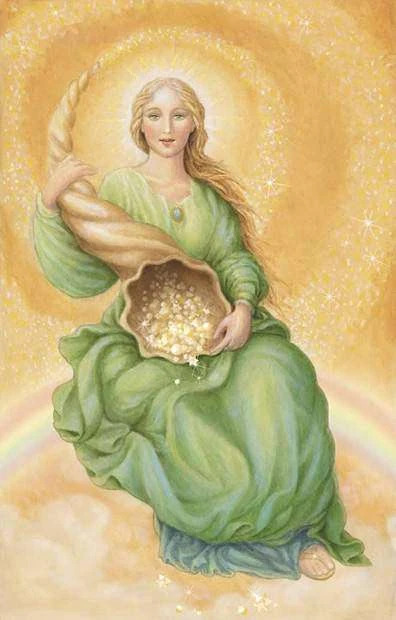
HER IMAGE
The goddess of abundance and prosperity was depicted on Roman coins that were issued in the 3rd century CE. On the coins, she’s portrayed seated on a chair with her famous symbols, the Cornucopia, which she holds or tips over slightly to make the riches pour out. She’s sometimes depicted on coins with ears of wheat and at other times, she stands on a ship’s prow, representing the Roman Empire’s overseas conquests.

IF YOU ARE A HEATHEN OR A HEDONIST OF A PURE HEART, OR CAN APPROACH THIS GODDESS WITH THE SAME LEVEL OF LOVE, RESPECT, AND COMPASSION AS YOU WOULD A LOVING CARING MOTHER, YOU CAN DEFINITELY COUNT ON HER TO LEAN ON FOR SUPPORT. YOU YOU ARE SEEKING GREATER WEALTH OR ARE INVOLVED IN FEEDERISM AND SEEKING TO BETTER PROVIDE AND STOCK UO ON FOOD, SHES YOUR GODDESS, SO LONG AS YOUR A GOOD PERSON AT HEART THAT IS.
#hedonism#abundantia#roman goddess#roman religion#paganism#prayforturkey#cornucopia#bountiful#fruitful#mother goddess#luxury#minor gods#gay feederism#plentiful#prosperity#wealth#hellenic pagan#gluttnous#royalty
35 notes
·
View notes
Note
One point to make is that human history may be euhemerized mythology, and the line between god and man (or, dead hero who is variously a god below or god above) can be very blurred. Early Roman history- even going as far as the Gallic Sack- has been noted to resemble common IE mythological motifs, which is especially notable given that the Romans seem not to have preserved any native (not literary greek) *myths* about the gods.
In other words, Abraham may have been a god who was reimagined as a human figure, perhaps in accordance with the needs of early monotheists, much like how Snorri imagined Óðinn as an ancient mortal wizard-king.
Heracles himself may well have been a god "first", for whom a myth of ascent developed. Certainly in terms of comparative religion, the Greeks considered him a god more than they did a hero.
Ah, thank you, this is a great point.
8 notes
·
View notes
Text
2 Odins?? Post01 (2/4)
Continued from Post01 (1/4)
So now that we've established possible connections putting Kaeya in the position of a second Odin... why two Odin's in the game? Why have an Odin that seems to share many traits with the mythological figure including physically (the Statuette drops depicting presumably an older bearded man, Irmin) and ... a young man with an eyepatch? For that, we have to discuss syncretism.
---
The Oxford dictionary definition relevant to this defines syncretism as: the amalgamation or attempted amalgamation of different religions cultures or schools of thought. An example of this would be how commonly Roman and Greek gods are equated with one another. This is because the Romans syncretized their gods to the Greek gods in a, "Oh you have a Greek goddess named Hera? OH!!! That's our Roman goddess Juno! Yea we call her something different but they're totally the same. Dude trust us." And this is a practice they would continue as the Romans conquered. As the Romans moved towards Gallic territory they would encounter Woden/Odin (I will continue to refer to this god as Odin for simplicity's sake) and syncretized him to the Roman god Mercury. And Merucry... is basically just the Greek Hermes taken by the Romans and shoved together with some minor Roman gods into a new shiny god of their own. So by way of Mercury, we've now established a connection between Odin and Hermes which now gets us to where we need to be.
Much of our modern interpretation of Hermes is taken from the Classical and Hellenistic period where he's depicted as a clean-shaven young man. However, older depictions of him from around 800 BC - 480 BC in the Archaic period had him depicted as an older bearded man. And this appearance has connections to the fascinating intertwined history of Hermes and the god Pan which I do highly recommend looking into if you're interested but not important right now. But through this connection we can have King Irmin as Odin by way of the older bearded Hermes as well as Kaeya as a younger Odin by way of the physically younger Hermes. It makes you wonder, how many traits of Hermes can be ascribed to Kaeya?
((A bit of a tangent that I acknowledge PROBABLY is not true as the shapes are quite different and discussions on visions and their casings are a whole can of worms on their own...but... wouldn't it be funny if the two "wings" missing from Kaeya's Mondstat vision casing were ripped off to be turned into the two dangling acessories on the anklet over his boots? Two wings springing from his ankles à la Hermes perhaps? ))

Continued in Post01 (3/4)
#genshin theory#genshin impact theory#Post01#I'm glad the keep reading insert worked correctly in the previous post!#now I'm hoping the photo insert works correctly here#kaeya alberich
4 notes
·
View notes
Text
Ancient Roman Mythology part 1


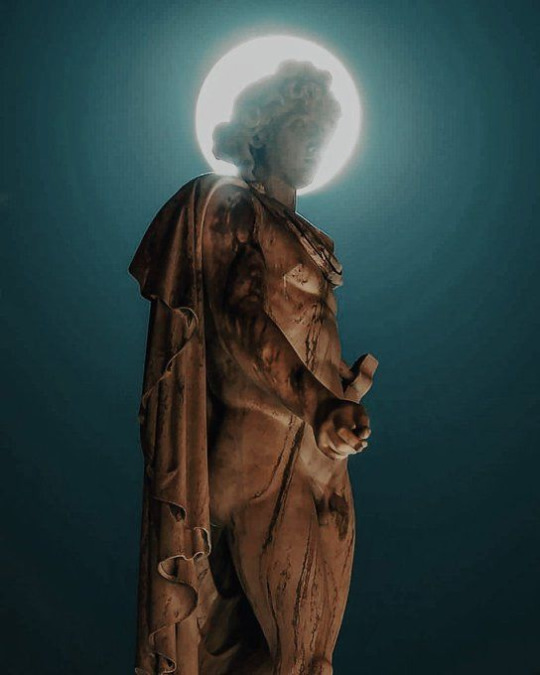

In modern historiography, ancient Rome encompasses the founding of the Italian city of Rome in the 8th century BC, the Roman Kingdom (753–509 BC), Roman Republic (509–27 BC), Roman Empire (27 BC– 395 AD), and the collapse of the Western Roman Empire in the 5th century AD.
Ancient Rome began as an Italic settlement, traditionally dated to 753 BC, beside the River Tiber in the Italian Peninsula. The settlement grew into the city and polity of Rome, and came to control its neighbours through a combination of treaties and military strength. It eventually controlled the Italian Peninsula, assimilated the Greek culture of southern Italy (Magna Grecia) and the Etruscan culture, becoming a dominant power in the Mediterranean region and parts of Europe. It was among the largest empires in the ancient world, with an estimated 50 to 90 million inhabitants, roughly 20% of the world's population at the time. It covered around 5 million square kilometres (1.9 million square miles) at its height in AD 117.
Ancient Roman civilisation has contributed to modern language, religion, society, technology, law, politics, government, warfare, art, literature, architecture, and engineering. Rome professionalised and expanded its military and created a system of government called res publica, the inspiration for modern republics such as the United States and France. It achieved impressive technological and architectural feats, such as the empire-wide construction of aqueducts and roads, as well as more grandiose monuments and facilities.
Republic
By the end of the sixth century, Rome and many of its Italian neighbours entered a period of turbulence. Archaeological evidence implies some degree of large-scale warfare. According to tradition and later writers such as Livy, the Roman Republic was established c. 509 BC, when the last of the seven kings of Rome, Tarquin the Proud, was deposed and a system based on annually elected magistrates and various representative assemblies was established. A constitution set a series of checks and balances, and a separation of powers. The most important magistrates were the two consuls, who together exercised executive authority such as imperium, or military command. The consuls had to work with the Senate, which was initially an advisory council of the ranking nobility, or patricians, but grew in size and power.
In the 4th century BC, Rome had come under attack by the Gauls, who now extended their power in the Italian peninsula beyond the Po Valley and through Etruria. On 16 July 390 BC, a Gallic army under the leadership of tribal chieftain Brennus, defeated the Romans at the Battle of the Allia and marched to Rome. The Gauls looted and burned the city, then laid siege to the Capitoline Hill, where some Romans had barricaded themselves, for seven months. The Gauls then agreed to give the Romans peace in exchange for 1000 pounds of gold. According to later legend, the Roman supervising the weighing noticed that the Gauls were using false scales. The Romans then took up arms and defeated the Gauls. Their victorious general Camillus remarked "With iron, not with gold, Rome buys her freedom."
Late Republic
After defeating the Macedonian and Seleucid Empires in the 2nd century BC, the Romans became the dominant people of the Mediterranean Sea. The conquest of the Hellenistic kingdoms brought the Roman and Greek cultures in closer contact and the Roman elite, once rural, became cosmopolitan. At this time Rome was a consolidated empire—in the military view—and had no major enemies.
Foreign dominance led to internal strife. Senators became rich at the provinces' expense; soldiers, who were mostly small-scale farmers, were away from home longer and could not maintain their land; and the increased reliance on foreign slaves and the growth of latifundia reduced the availability of paid work. Income from war booty, mercantilism in the new provinces, and tax farming created new economic opportunities for the wealthy, forming a new class of merchants, called the equestrians. The lex Claudia forbade members of the Senate from engaging in commerce, so while the equestrians could theoretically join the Senate, they were severely restricted in political power. The Senate squabbled perpetually, repeatedly blocked important land reforms and refused to give the equestrian class a larger say in the government.
Gaius Marius soon become a leader of the Republic, holding the first of his seven consulships (an unprecedented number) in 107 BC by arguing that his former patron Quintus Caecilius Metellus Numidicus was not able to defeat and capture the Numidian king Jugurtha. Marius then started his military reform: in his recruitment to fight Jugurtha, he levied the very poor (an innovation), and many landless men entered the army. Marius was elected for five consecutive consulships from 104 to 100 BC, as Rome needed a military leader to defeat the Cimbri and the Teutones, who were threatening Rome. After Marius's retirement, Rome had a brief peace, during which the Italian socii ("allies" in Latin) requested Roman citizenship and voting rights. The reformist Marcus Livius Drusus supported their legal process but was assassinated, and the socii revolted against the Romans in the Social War. At one point both consuls were killed; Marius was appointed to command the army together with Lucius Julius Caesar and Lucius Cornelius Sulla.
Marius died in 86 BC, due to age and poor health, just a few months after seizing power. Cinna exercised absolute power until his death in 84 BC. After returning from his Eastern campaigns, Sulla had a free path to reestablish his own power. In 83 BC he made his second march in Rome and began a time of terror: thousands of nobles, knights and senators were executed. Sulla held two dictatorships and one more consulship, which began the crisis and decline of Roman Republic.
0 notes
Text
Right-wingers freak out because Miss France has “woke” short hair
Look up the original definition of “woke” circa 2020 and you’ll find “alert to racial prejudice, discrimination and white supremacy.”
Now, for muckraking tabloids and probably Florida Governor Ron DeSantis (R), “woke” apparently just means “short hair.”
Related:
Far-right Republicans are now calling Mike Johnson “woke” over LGBTQ+ military provisions
Mike Johnson’s views are extreme, but some Republicans don’t think he’s extreme enough.
The newest definition comes in the wake of 20-year-old Eve Gilles taking the title of Miss France last Saturday night. The French beauty representing Nord-Pas-de-Calais snatched the crown sporting a pixie cut straight out of a 1990s supermodel lookbook.
Never Miss a Beat
Subscribe to our daily newsletter to stay ahead of the latest LGBTQ+ political news and insights.
Promotions (occasional)
*
Week in Good News (one on the Weekend)
*
Week in Review (one on the Weekend)
*
Daily Brief (one each weekday)
*
Sign Up
It was the first win for a Miss France contestant with short hair in the competition’s 103-year history.
Eve Gilles, a woman with short hair wins miss france and the tabloids get angry saying the judges have gone ‘woke’ as her hair isn’t long. i feel they’ve gone with a fabulous 80/90 vibe and a look that is strikingly different from the other woman. #MissFrance pic.twitter.com/ho9AcKTPzR— emma woodcock (@Green_Yogi) December 18, 2023
“We’re used to seeing beautiful Misses with long hair, but I chose an androgynous look with short hair,” explained Gilles after the contest.
It was a win for “diversity”, she said, adding that “no one should dictate who you are.”
The model-thin beauty queen, who grew up wanting to be an equestrian, shared during the contest, “I would like to show that the competition is evolving and society, too. That the representation of women is diverse. In my opinion, beauty is not limited to a haircut or shapes that we have — or not.”
“Every woman is different,” she added. “We are all unique.”
But not according to the right-wing outrage machine ginning up a controversy that doesn’t really exist. Leading the charge: the UK’s far right-leaning Daily Mail.
“Critics said the kind of long hair favored by previous winners – and Gallic female icons such as Brigitte Bardot and Catherine Deneuve – would have been far more appropriate than a short pixie bob,” snarked the British tabloid, without quoting those critics in particular.
The Franco-phobic Telegraph jumped on the scrum as well, describing Miss France as “boyish” and “androgynous”.
And according to more than one post on Elon Musk’s X, Gilles’s triumph for “diversity” is just another rigged result of the left’s obsession with “woke”.
“Miss France is no longer a beauty contest but a woke contest which is based on inclusiveness,” read one tired take.
“We don’t care about her haircut, but the androgynous body is obviously there to serve as woke,” read another.
It was left to French-American actress Beatrice Rosen of 2012 fame, and no “woke” fan herself, to disarm fellow right-wing critics with a spirited defense of Gilles.
“I understand that there is a real element fed up with the wokism that they are trying to make us swallow 24/7, BUT, in the same way that we can criticize a religion but NOT the faithful, I find the sometimes nasty criticisms regarding Eve unfair and counterproductive.
“Attacking the physical is an attack below the belt, and putting the weight of the total ideological criticism of Wokism on a young woman of 20 is unfair.
“This young woman is pretty, and feminine ‘despite’ her short hair. I was and still am an admirer of the singular beauty of Audrey Hepburn, Linda Evangelista, or Jean Seberg, all 3 very thin with short hair, and who nevertheless are female icons who have been adored in the whole world.”
Bravo à Ève Gilles pour son élection à Miss France 2024.
J'ai lu les critiques et voici mon… http://dlvr.it/T0ZVJ1
0 notes
Note
This is gotta be some destiny coincidence, because I was about to ask you what are your main interests in Ancient Greece, Rome and Ancient civilizations in general. Like, people, themes, stories, events, history itself, whatever you like about them
LMAO. truthfully, i’ve just been brainstorming more about my ancient greek female scholar story so i’ve been doing some research. specifically into the setting. i originally had planned for it to be in athens for her to attend the platonic academy, but given that athenian women were so restricted that it’s almost impossible to give her any real freedom of movement, i’ve been having to reassess.
i love how legendary antiquity seems to me. so much of it is wrapped up in half-formed theories and speculation that it comes off almost like a myth. like all roman history until the gallic sack (i think?? correct me if i’m wrong) is one big mystery. i find that so fascinating. it’s also because the life was so different. their religions were so different. they had none of the technology that makes our life so easy today. as for what i loved, specifically, about each society. i love learning about ancient greek religion. their cults. i love how aphrodite was originally ishtar. i love the common thread there is in indo-european religions, and the cultural drift. i’m intrigued by the similarities of roman governance and american governance. i love the julio-claudian dynasty. i love sulla and marius’ civil war. i love the early republican days. i love cyrus. i love how influential he was on basically every ruler that came after him. i love how fucking old the mesopotamians are. same with the egyptians. their age is almost mystical to me.
anyway, if you want to help me puzzle out the setting and the particulars that would be so fun! i Love talking about greece.
0 notes
Text
The gods of Gaul: Cernunnos
Cernunnos is without a doubt one of the most famous gods of Ancient Gaul, and yet he is actually one of the most mysterious Gallic deities. Sure, he definitively marked the imagination of people - I mean he was literaly used as the basis for the Wiccan Horned God, and you will see lots of Cernunnos-copycats in fantasy RPGs and the like. But... we actually do not know the truth about this god, and despite everybody on the Internet trying to make it sound like we have an easy and simple summary of what he is, we only have strong theories and conflicting hypothesis.
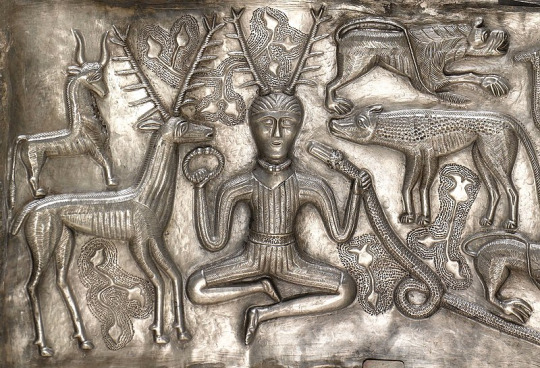
I/ What we actually have
As with a lot of Gallic gods, Cernunnos exists not in legends or myths, but through a name and a visual. The name Cernunnos is found three times all on its own in Gallic documents. One was a Greek inscription from Montagnac that only says "This is dedicated to Karnonos of Alisontia". The other two are identical inscriptions found in Luxemburg (near Steinsel), votive inscriptions of wish-offerings merely saying "Deo Ceruninco". There is actually a fourth inscripton of the name Cernunnos - and it is from this one that we get the spelling we use today - but it is a special one. Unlike the other three, this one has a picture alongside it identifying the god visually. It is the famous "pilier des Nautes" found under Notre-Dame-de-Paris, the "pillar of the Nautes", the "pillar of Boatmen", considered one of the most important Gallic monuments (because it depicts a set of divine portraits with their names explicitely spelled out).
It is only thanks to this pillar that we know today that the many depictions of a male horned god found across Gallic art are meant to be Cernunnos. There are too many visual depictions of him to be listed here (sixty or so were found by archeologists), but among the most famous is the one I put a picture of above: the Cernunnos of the Gundestrup cauldron found in Denmark.
Here is what Cernunnos looks like on the pilier des Nautes:
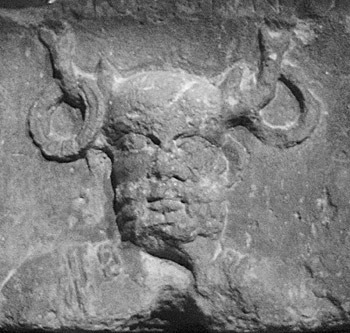
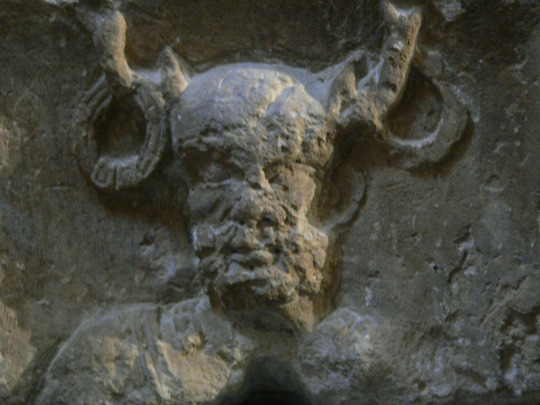

So, we have a name and a bunch of pictures. Let's try to break it all down.
When it comes to the name, Cernunnos/Karnonos, it is commonly agreed by etymologists and those that studied the Gallic language that it means "the horned god". "Carnon/Karnon/Karn" was known to mean "horn", both in the sense of animal's horn and a blowing instrument - it was tied to the Gallic tribes known as the Carni and Carnutes, and to the Celtic carnyx. The "kern" part is also considered to be equivalent to the Old Irish "cern", which was associated with horned beasts. Some have pointed out that if the "Cern" of "Cernunnos" means horn, the "unnos" could be a suffix meaning "beautifully" - so instead of Cernunnos being the "horned god" or the "horned one" it would mean "He who is beautifully horned" or "He with beautiful horns". But all in all, his name stays connected to horns.
[But is it truly his name? This is another debate typical with the gods of Gaul: we do not know the differences between the proper names, the titles and the nicknames. It could be (to take a Greek comparison) like Hestia's case, where he names literaly means "hearth" but is a proper name ; or it could be like the "Old Man of the Sea" which was a generic nickname for a whole group of sea deities.
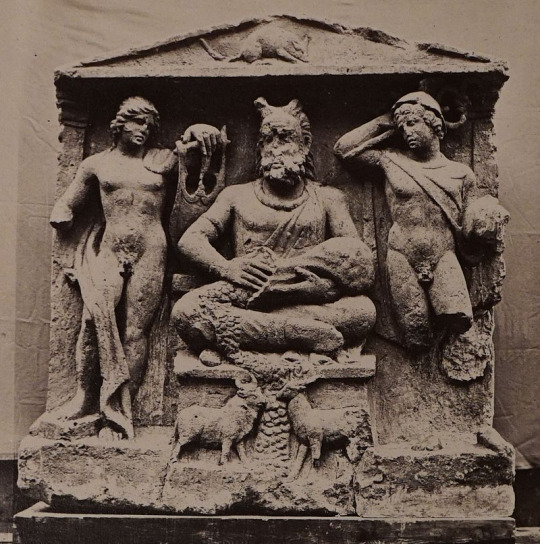
Now let's talk about the images of the god. Thanks to having so many depictions of him, we can identify recurring traits that define his visual.
Cernunnos always appears with his legs crossed, in a position (the "lotus" or "yoga positon" to take Asian terminology) that is considered, depending on the sources, either "very unusual for a god of Gaul", either "absolutely typical of Celtic representations of gods, warriors and heroes"... Well, he is almost always in the "lotus position" - in rare cases, he can be standing up. Cernunnos is also always wearing a torc, the traditional Gallic ornament, though he isn't always wearing it around his neck as one would expect: sometimes he holds it in his hands, other time it hangs from his antlers. Speaking of antlers: as we said, Cernunnos is a horned god, and he is usually depicted with antlers. But sometimes, more rarely, he rather sports goat horns - maybe it is a Romanization effect, as he got confused with Pan?
Cernunnos is always a male figure, though his actual age is unclear. Sometimes he is a mature and bearded man, but we also have "ephebe" depictions of him as a beardless youth - that some researchers even go as far as to describe as "child-like". Similarly, he keeps oscilatting between being a singular entity, and a triple-god with three heads or three faces. The disposition of the three faces can be really weird and freaky - for example, he can have a regular human head, and two small human faces growing from either side of his neck, or from the top of his head.
He usually always has a bag or basket with him, a bag that he eithers opens or that is simply sitting before him, spilling its content: sometimes the bag is filled with food, other times with coins, and other tims yet with grain. Cernunnos is usually sitting in the middle of a trio (as in two other humaoid or divine figures are by his side), or he is surrounded by various animals - which he can be seen holding with one hand, or petting near his lap. There are various animals he is associated with - we have seen him with stags, with bulls, with rats, with dogs, with lions, with goats... He is most notorious for being often depicted with the symbolic-mythical beast of Gaul known as the cryocephal snake: a ram-headed snake, whose exact meaning is still unclear to this day. However, Cernunnos seems to really like them: sometmes they just sit side by side, sometims he holds it by the throat, sometimes he feeds it, and other times two of them sit on his lap.

(This depiction above lacks any horns, but there are two holes at the top of the head implying that the horns were a different part of the statue added separately - which is very interesting in the theory of Cernunnos having antlers that "fall")
One of the problems with the Cernunnos visuals is that it is not clear where they stop, as we got a wide range of variations between the animal and the man. For example, there are strong theories according to which Cernunnos appears on the Strettweg chariot, as the tiny deer with oversized antlers that two men are holding (which would mean Cernunnos could be depicted as a full stag without human traits):
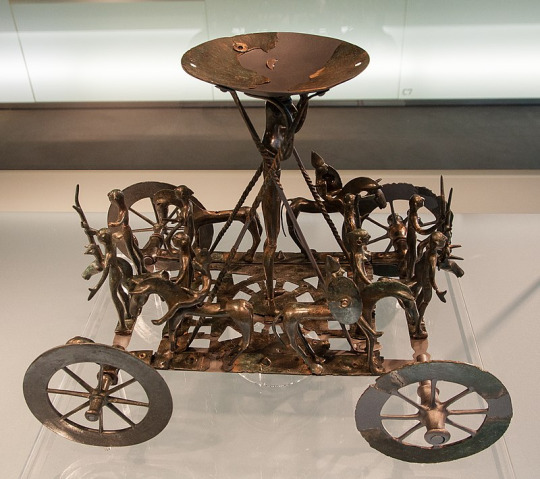
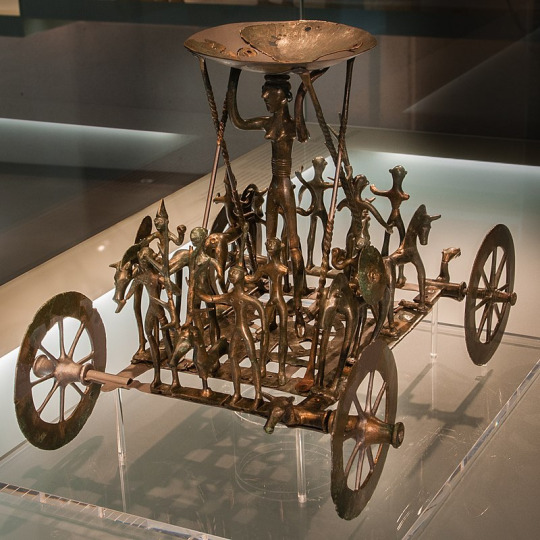
And on the opposite spectrum, a Gallo-Roman statue was found in Amiens of a fully human deity... except for one deer ear on the side of his face. One of the theories to explain this bizarre statue of the first century claims that it is an hyper-Romanized depiction of Cernunnos - though other theories do exist (for example, when the statue was discovered, it was originally believed to depict Midas, with a variation of the "donkey ear" punishment):

And you also have in Bouray a cross-legged god with deer legs rather than antlers or ears:


Given how "late" the visual depictions of the gods of Gaul was, and how the Romanization of Gaul strongly encouraged and favorized the depiction of deities as humanoids (to fit with the Greco-Roman deities), it is very likely that Cernunnos started as a divine stag, as fully animal, and then slowly, especially under the Roman influence, became more and more humanized... (There's also a fascinating case of antlered-goddesses at Clermont-Ferrand and Besançon, but that's for later).
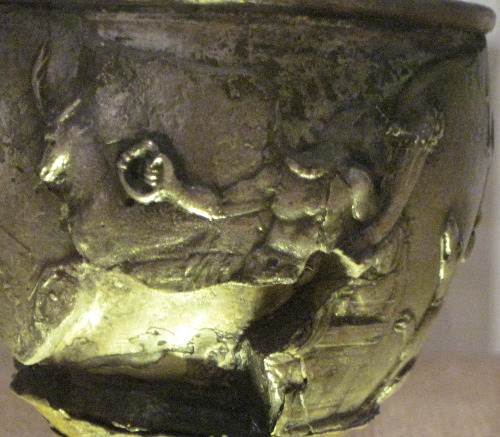
II/ Some theories
Now that we have the name and the visuals done... What's Cernunnos deal? Again remember we can only make theories based on these fragments and their context - but we do not know for certain if it is the truth.
A: It is agreed that Cernunnos is a nature god, and a god of abundance. The fact he is half-stag, and usually depicted with animals, and even holding them in a gesture of domination or use, shows that he is a fauna god, which prompted some researchers to identify him as one of the avatars of the "Lord of Animals, Master of Wild Things" archetype of Indo-European myths. But more importantly we are certain that he dealt with abundance and prosperity - thanks to him always having a big bag of grain, food or money. He was very clearly a god of riches and wealth - be them natural (grain, food) or manufactured (coins). Some have highlighted the idea that this tied to the symbolism of "forests that have big strong stags in them are bound to be fertile places filled with resources". Cernunnos' ties to abundance cannot be denied because in some Classicized depictions of him (such as the silver goblet above), he is literaly seen holding a cornucopia, aka a horn of abundance.
Some people even want to push the domain further by thinking Cernunnos might have been a god of sexual and reproductive fertility - but this is not based on any visual or religious clue. Rather this theory ties on the European symbolism of the stag as a symbol of virility and reproductive prowess, so it is a purely contextual reading, to be handled carefully. We are only truly certain that Cernunnos offered lots of money, lots of grain, lots of food, and lots of animals (him being surrounded by animals might be an extension of the "I offer you this bag of grain" visual, since animals were hunted down for food, so he isn't just a god of good crops and economic riches, but also one that ensures a plentiful hunt).
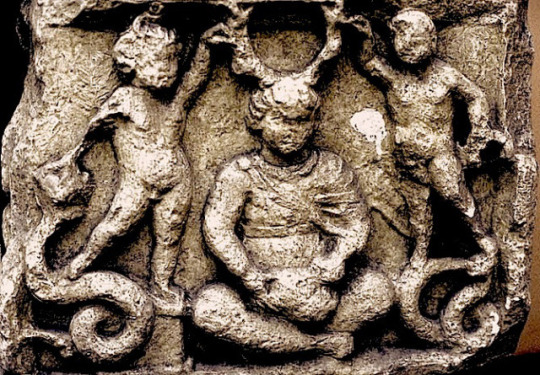
B: There is a strong theory going around that Cernunnos might be a seasonal god, or a deity of the seasonal cycle. This idea comes from various elements pieced together - and which added with the A theory above, would make this go a sort of "Father Nature" figure. It all starts wth the European symbolism of the antlers and the stag in general: given the antlers fall and grow with the turn of the seasons, the stag has been used heavily in Europe as a way to measure the year or symbolize seasons. Some researchers theorized, based on how the size of Cernunnos antlers changes through depictions, and on how he is sometimes a beardless youth sometimes a bearded mature man, that Cernunnos, like the stag, had a seasonal cycle. For some he just loses and grows back his antlers (there is a Cernunnos depiction at Meaux with what seems to be the stubs growing back after antlers fall, which would support this theory), but others push it further by claiming the god died and was reborn each year with winter/spring - an idea inspired by the Indo-European archetype of the dying/sacrifical vegetation god.
There is a specific depiction of Cernunnos that ties into this whole - and I will have to trust Yann Brekilen's word for this, as I couldn't find any picture of the engravings he described. According to him, on the Gallo-Roman Germanicus Arch/Arc, by Saintes, there is a dual depiction of Cernunnos. On one side of the Arch, he is part of a trio: he is sitting crossed-leg with antlers on his head, but naked (usually Cernunnos s clothed in some ways). By his side there is a man armed with a club/mace (which might be tied to the "god with the mace", we'll see that in later posts), and a woman holding a cornucopia. Now, that's on one side of the monument - but on the opposite side, the scene is reproduced... with both the armed man and the antlers of Cernunnos missing, only leaving a regular cross-legged naked man, and the cornucopia-woman. Speaking of this cornucopia-woman: there are repeated talks and interpretations of any female figure by Cernunnos' side to be a "Mother-Goddess" or Earth-Goddess supposed to be the wife/companion/lover of Cernunnos. This is all part of an effort to make Cernunnos a "father-god" (which makes sense in some ways), and it ties into the whole reading of his myth as being a seasonal cycle (the god dying and resurrecting after impregnating his female counterpart ; something the Wiccan mythology for example reused in their beliefs), but... If you ask me, I am not really convinced? A lot of people insist on there being a "Mother Goddess" clearly by Cernunnos' side, but sometimes you see these people reinterpret a lot of the visuals, and it is not obvious that the female figure is with him (Cernunnos is usually surrounded by male figures rather than female ones). Plus, we know the Mother Goddess of Gaul tended to come in three (the famous Matronae) so... I am a bit doubtful of that, but that's just me and because of a lack of convincing evidence.
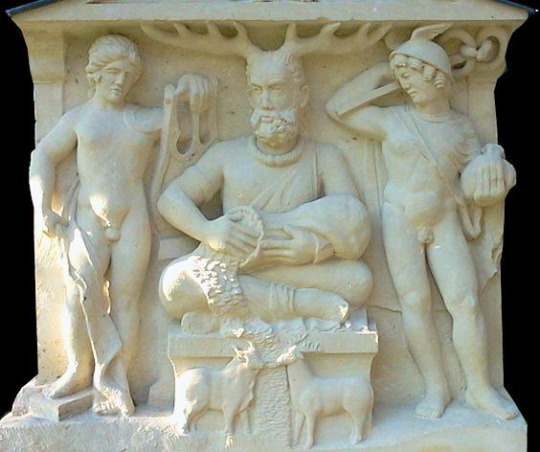
III/ Comparisons and equivalences
As I said in my introduction post, a lot of what we know about the Gallic gods comes from the syncretism the Romans operated with their own deities. And with Cernunnos it is... complicated. Because we do not know exactly who was the Roman equivalent of Cernunnos (since the Romans did not speak of him), and based on researches we have two likely candidates. It is very possible Cernunnos might have been split into those two Roman deities, or at least that his attributes led him to be interpreted as two deities mixed in one.
On one side, there is a very strong and popular theory that Cerunnos was the god Cesar, in his description of the religion of Gaul, called the "Dis Pater". "Dis Pater" was the Latin god that was equated and synthesized with the Greek Hades under the share nickname "Pluto", "the rich one". This was because Dis Pater was not originally a god of the dead in the old Italian religion - he was an underground god, indeed, but a chthonic god of riches and wealth, an earth-god of fertility (his very name meant "Rich Father"). This is what tied him to Hades, the richest of the Greek gods - and made him the new god of the underworld and the dead, Pluto. So, equating Dis Pater with Cernunnos makes sense as we do know that both deities were strongly associated with an earthly form of fertility: Cernunnos, just like Dis Pater, brought grain and earth-grown fruit, as well as precious metal (in the form of coins). Not only that, but Cernunnos was strongly associated with the ram-headed snake, and while we don't know much about this mythical being (typically a companion of male gods in Gallic art), it seems to have been a chthonian symbol, and perhaps even a form of guardian of the world of the dead (or a guardian of underground riches cousin of the dragons of legends). This is what led many to interpret Cernunnos as a chthonian deity, perhaps even an afterlife deity - a tradition that seems to have been in early Christian art, where Cernunnos was often associated with the "mouth of Hell" or the "entrance to Hades" (like the 9th century manuscript Stuttsgart Psalter, which illustrates Cernunnos in a depiction of the Christ descending into Limbo.
If Cernunnos is indeed Cesar's Dis Pater, then it would be extremely interesting, because Cesar wrote in his records that the peopleof Gaul believed Dis Pater to be their divine ancestor, and the "father of their race". Aka, the Gallic Dis Pater is meant to be an All-Father, the first ancestor of the Gallic tribes, and the origin of the human race (or at least of the people of Gaul). If Cernunnos is this Dis Pater, it would confirm his role as a "Father-God" and his links to a potential "Mother-Goddess". (It could also explain why he so persistantly wears a torc, as an emblem of the civilization and traditions of Gaul) If Cernunnos is also the Dis Pater, it would give him a role as a nocturnal god, since Cesar resumed in his texts (or rather "recaped" since he was doing a report based on Posidonius own records) that it was because the people of Gaul descended from Dis Pater that the druids measured the time not in "days" but in "nights"...
The other very likely candidate for the Romanized Cernunnos is the one we call the "Gallic Mercury". We know that Mercury was one of the most popular and widespread gods of Gallo-Roman gaul. Cesar did mention him as one of the most important gods venerated by the Gallic tribes before the omans arrive (though this would contadict the is Pater theory, since Cesar identifies Dis Pater and Mercury as two different deities in the Gallic beliefs). Still, Mercury was a god of commerce and riches before all - even more so than his Greek counterpart Hermes - so it makes sense that he would be present in the Gaul province of the Empire, which was big heart of commerce. And where Mercury has a pouch of coins, Cernunnos has a full bag of them... And in several Gallo-Romans depictions one of the two gods that surround Cernunnos is very obviously Mercury... [Several of the images in this post are of the altar of Reims, which depicts Cernunnos surrounded by Apollo on one side and Mercury on the other] And Cernunnos' presence on the Pillar of Boatmen implies he was tied to the fluvial sailors, and to the fluvial commerce and travels... And in Luxembourg we have Gallic depictions of stags vomitting coins, again insisting on how the stag was associated with riches... Even if you take Cernunnos as a chtonian god or death god, it ties to Mercury's role as a psychopomp inherited from Hermes ; and Mercury's presence by Cernunnos side on the altar of Reims for example makes sense if you consider one of the deities Cernunnos was conflated with was Pan (hence the goat horns) - aka, the son of Hermes... Everything is tied together into one big convoluted web of inter-mythologies.

And when it comes to comparisons to other Celtic mythologies, things are a bit... In French we say "vaseux" - basically there were parallels drawn between Cernunnos and Celtic figures of the Isles, but they rely on very meager if not unstable links. For example some have tried to identify the Cernunnos of Gaul with the Irish figure of Nemed (interpreted as a "stag-god" leading "stag-people" or "deer-people"), and in return the battle between Nemed and Balor for the land of Ireland was projected onto the scene depicted on the Arch that I described prior - a battle between the horned god and the god with the mace for the "earth-mother", the cornucopia woman, the land-goddess. The acceptance of this scene between the horned god and the mace god as a battle for the mother-goddess (which, I insist, was not PROVEN in any way and is completely hypothetic and theorized with no definitive proof - maybe the mace god is here to sacrifice the horned god for the cornucopia-woman, or maybe he is just here to cut off his antlers, or maybe the cornucopia woma cheats on Cernunnos wit the mace god, we cannot know), also led to vague comparisons being drawn to the story of Pwyll and Arawn and how they exchange each other's identities, but we are really in a stretch here.
More interestingly there is a Welsh comparison that could indicate a leftover of a Christianized Cernunnos in an Arthurian setting: the Owein tale (Mabinogi): Kynon, a knight of King Arthur's court, describes how in his youth he had to encounter an ugly knight clad in a black armor who had the information he needed to find his enemy. The knight lived by a "fountain" (a water stream) surrounded by wild and ferocious animals - and to give Kynon the information he needed, the ugly black knight struck a stag nearby, and the animal lowers its head in the direction Kynon must follow. It is very plausible that this supernatural knight who hits an informative stag and who lives surrounded by wild animals is a form of Christian censorship or caricature of a Cernunnos figure, going from a wise and benevolent stag-god to an ugly evil knight who abuses animals, and who has his duality human/beast split between the knight and the stag.
There were also tenuous elements that made people consider the Irish Conall Cernach (known for being one of the sidekicks of Cuchulainn) as a diluted version of Cernunnos as a "Master of Beasts" - more precisely an episode in "The Cattle Raid on Fraech" where instead of killing a monstrous snake, Conall somehow tames it and wears it as a belt, has been compared to Cernunnos' handling of snakes and ram-headed snakes. And don't even get me started on the many, MANY saints of Catholicism that are supposed to be leftovers or reinventions of Cernunnos (saint Ciaran of Saighir, because he tamed wild beasts including a stag ; or the saints of Bretagne Edern and Théleau both supposed to ride a stag instead of a horse...).
The complicated thing (well ONE of the complicated things) with Cernunnos is that he is tied to the stag, and the stag was one of the most prominent smbols and images of the medieval and proto-medieval imagery in Western Europe. You had lot of old mythology stuff that survived in modern days, but you also had lots of medieval symbolism and images (like how the flying stag was one of the symbols of the king of France), and a HUGE re-use of the stag by Christianity in various forms (from the antlers falling being used as a symbol of the Resurrection, to the hunt for the white otherwordly stag of Celtic myths suddenly becoming a hunt for Christ incarnate when a glowing cross appears above the stag's head...). As such it is hard to pin-point what the Gauls truly believed the stag meant, versus the stag symbolism that arose in the Middle-Ages.
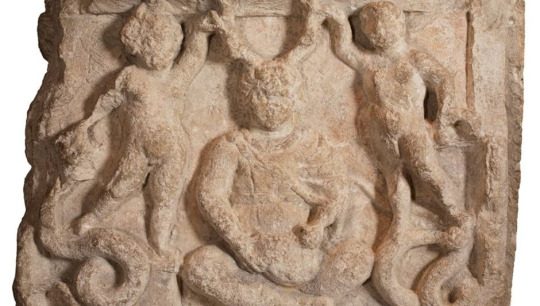
To conclude this post, while I said I had my doubts with systematic identifications of Cernunnos as a companion of a Mother-Goddess, I want to briefly return about a fascinating trivia of Gallic researches: the existence of a female version of Cernunnos, a "Cernunna" we could jokingly say.
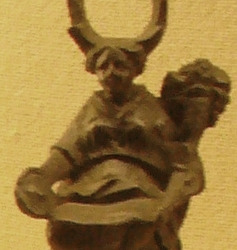
Little figurines and statues were found of a horned goddess - sometimes with antlers! - in both the area of Clermont-Ferrand (which was the domain of the Avernes folk) and around Besançon (the Séquane folk). Who were these goddesses? Local variations of Cernunnos? Sisters, daughters or wives of the god? Or completely unrelated deities? Were they one or several (some are more matronly, motherly figures such as the one with antlers above, others have Venus-like poses unveiling their breast and legs such as the bull-horned below)?
We will probably never know - but while they can be incarnations of this famed "Mother-Goddess" companion of Cernunnos everybody speaks about (and links to the importation of the cults of Demeter and Cybele in Gaul), it is VERY likely these statues date from the Gallo-Roman era and from a Romanized version of the Gallic religion. Indeed, they are all tied by their attributes - they hold a cornucopia, and a "patère" (sacred vase for religious libations). Attributes present in very Romanized Gallic goddesses (such as Rosmerta), but also in typical Roman deities (mainly the lares). Add to that how the adjunction of a male attribute (the stag antlers or bull horns) to a female figure is VERY unusual for Gallic depictions (where the genders are neatly split), while the divine androgyny was a feature of Greco-Roman mythology (the effeminate Apollo and Dionysos, the masculine goddesses Athena and Artemis, the mythical Hermaphrodite...), and it is very likely these statues of the "Cernunna" are the result of the Roman religion "breeding" with the Gallic beliefs...
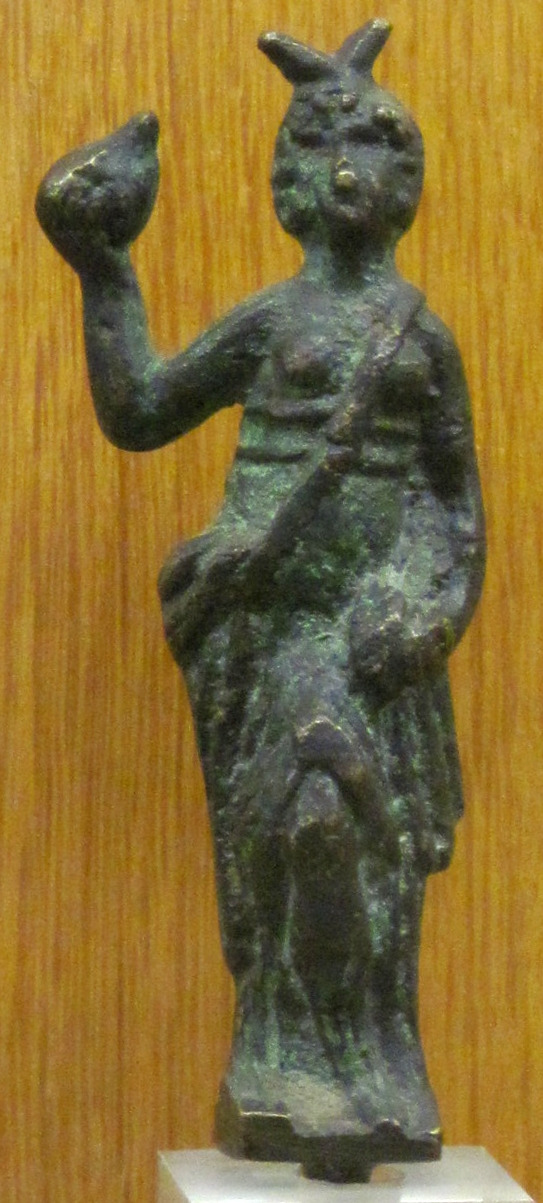
#gods of gaul#gallic mythology#cernunnos#ancient gaul#religion of gaul#gallic religion#gallic gods#gallic goddesses
126 notes
·
View notes
Text
Roma invicta march

#Roma invicta march free#
Support a hobby game developer in his first commercial game, all done by himself.
Different starting conditions and difficulty levels ensure replay value.
Vallejo Black Grey Model Color Paint, 17ml. Sold by Dark Moon Enterprises and ships from Amazon Fulfillment.
#Roma invicta march free#
Get it as soon as Wednesday, Jun 22 FREE Shipping on orders over 25 shipped by Amazon. You decide whether to bring peace to the Gallic villages or whether to plunder them and thus further ignite the resistance against you. This item: Box Of Imperial Roman Starter Army Miniatures.Supply your troops and always pay attention to the changing of the seasons.Shop affordable wall art to hang in dorms, bedrooms, offices, or anywhere blank walls arent. T Shirt ROMA IDES of MARCH, Rome, Roman history, History lovers. Hand over parts of your army to the AI to always keep control even in larger battles. Unique Roma Invicta Posters designed and sold by artists. Roma Invicta Shirt, History Teacher Shirt, History Gifts, Ancient Rome, Roman Empire.It was an inspirational motto used until the Fall of the Western Roman Empire in 476 AD.This symbolic statement was later printed onto gold coins. Gaius Julius Caesar has only established t. Roma invicta is a Latin phrase, meaning 'unconquered Rome'. Slow down or pause the battle to always stay in control and give orders with no hurry. Crusader Kings 3 Royal Court is here and with it comes our Roman culture and Hellenic religion narrative campaign.Fight in tactical and action-packed real-time battles with hundreds of individual soldiers.Recruit your troops from legionnaires to scorpion artillery to Germanic cavalry. Another Rome 2 Total War timelapse, and the first time we actually see AI Rome not only do good, but dominate the mapMusic.Experience a lovingly handcrafted scenery of ancient Gaul.The game can best be described as a mixture of the old Amiga classic ‘North and South’ and the ‘Total War’ series. The game combines action oriented real-time battles with turn-based strategy on the campaign map where you raise, supply and move your armies. The campaign ends on March 27, which means about three days where things. And you can raise tyranny to deal with AE.In Roma Invicta you have the honor of conquering ancient Gaul with your Roman legions. I want to announce my attempt to implement a mod-support for Roma Invicta. Technology, good minister, also Rome has deity that speed up decreasing of AE. Only a few time surpass 50 AE, usually started wars with 20 AE. That was sufficient most of the time, but with 6 legions that way Seleucid make me suffer a lot before they surrender. 'March on Rome,' Bellona quietly urged, 'and you shall rise as no other. Later with multiple legions, 25 HI, 15 LC, 5 E, 5 ST, withouth any particular reason. Meanwhile could have only one legion and manpower wasnt unlimited I went for HI, later add HC, also Engies and Supply train, and made Legion as big as i could. Until late game wars with Seleucid, my wars was like blitzkrieg, I go straith to the fortress, but sometimes is better stop siege if you can crush enemy army. Make you legions always training, that adds a lot of experience, and war traditions is a big big bonus. It features vocals by Angela van Dyck, and bouzouki and mandolin by Saki K. In technology first I go for invention that make you able to recruit legion, then those which speed up the march of you troop, then those that increase you technology efficiency.ĭont wait to missions, a lot of lands started to conquer before I started respectivie mission. The Rome Total War Original Soundtrack was composed by Jeff van Dyck in 2003-2004. I see you already get excelent response, hovewer from my experience could add:

0 notes
Text
If you ever wanna throw up in your mouth, read literally any Wiccan/new age pagan thing about Irish deities
If I have to read one more article homogenising Irish culture with European culture, under the umbrella term “Celtic” while citing information that is specifically about Irish culture I may light my phone on fire
Listen, I’m spiritual and a bit new to it all, but I’m also Irish and have a degree in Celtic civilisation. The word Celtic itself is a misleading term - no culture in Europe referred to themselves as Celtic. It’s an umbrella term invented by racist Roman and Greek scholars, like barbarian. The Gauls didn’t call themselves this, the Gaels didn’t call themselves this, the Picts and the Welsh didn’t call themselves this. It’s a term that has a complicated history as it’s often used as a shorthand to homogenise very complex (and often culturally separate) societies. It’s only really a term applied to language groups (continental Celtic vs insular Celtic) and social movements (that are much closer to modern times than ancient ones). Tho sometimes historians are also guilty of using the pop culture shorthand to refer to north Western Europe as Celtic (after all the “celts” are technically still a grouping of many peoples, the term is helpful shorthand when discussing it in terms of invasion/encroaching cultures/or simply geographical nods, like Asia and Europe, homogenising for the sake of an overarching point/analysis).
Anyways, I saw somebody (multiple somebodies) refer to the god Lugh as “Celtic” not Irish. And yeah, he may have some connections to the continental god Lugus, who was a Gallic god, but aside from broad characteristics and root name meanings... there’s not much to connect them. But sure, if u accept that as connected, I respect ppl citing the comparisons.
But no comparisons are made. Instead, all of the Irish stories about Lugh, from the spelling of the name, to the mythology, (and the misinformation on said mythology a la the Victorian era), is written about and then termed “Celtic” - it’s like writing about Jupiter, citing every mythology story about him and then due to the clear connection to Zeus, determining that Jupiter is actually Panmediterranean, not a Roman god.
They did the same w/ Aengus Óg and they do this with all the Irish gods. I see “Celtic” and “panceltic” get thrown around. Irish culture is not celtic culture; it’s Gaelic culture (and a bunch of other cultures mixed in due to colonisation).
Look Irish ppl refers to themselves as celts sometimes, and so does the world, and overall it’s grand, it’s fine, it’s due to pop culture latching onto a word that isn’t accurate but ultimately harmless. But when new age religions start doing it it’s a whole other ball game. Non-Irish practitioners have a responsibility to Irish culture and the highly spiritual nature of Irish culture to actually... acknowledge that it’s ours. It isn’t “pan” anything. It’s Irish. It’s Gaelic. You don’t get to generalise it and misrepresent it because you want to tweak parts of it. Most of the stuff I see about “connecting” w/ these Irish mythological figures doesn’t even have anything to do w/ the stories that surround them. You lot keep adding things and making it up, like getting drunk as a sign of celebrating a god, like my guys that’s a freaking stereotype, drinking alcohol for the purpose of celebration (not to get drunk, that’s a Dionysian thing; Irish gods encourage banter, not oblivion) is meant for actual festivals... not just whenever. It’s just... a bunch of non-Irish ppl fetishising Irish culture. With stereotypes and American dreams on what that culture actually is.
Lugh isn’t a sun god! The “celts” didn’t coincide his four week sport games w/ the astrological sign Leo on purpose since the Irish didn’t believe in astrology ! Even if there is correlation it’s not because the “celts” interacted w/ the Greeks - Lugh and that specific ritual of Lugh’s is Irish and Irish alone; it had nothing to do w/ the sun or Leo, it was only to do w/ harvest times and games, pre-Christian Gaels liked to have fun! Lugh is a storm god, lughnasa *is* how we spell it now and it’s just storm season in Ireland. Hence it being named after a storm god. The Aes Sidhe, or Fairies, isn’t the thing you think it is, it’s not that Summer/Winter court stuff you see in fantasy novels.
The word Celtic is a broad term and it doesn’t mean Irish. Gaelic or Irish means Irish. We also call our language Irish. We don’t really call it Gaelic (it’s not incorrect, but we prefer Gaeilge). Celtic Catholicism *is* a thing and it’s specifically about Irish Catholicism. Yeah, I know what I said Celtic isn’t automatically Irish, but hey I didn’t get to name the type of Catholicism. It’s different than Roman Catholicism. We don’t mess w/ fairy trees and honestly I believe that is the remnants of very old laws about respecting the environment.
Words are a larger part of Irish heritage than alcohol. Written, verbal, whatever - language is the beating heart of this country. Stories, songs. It’s all we could retain after hundreds of years of cultural and physical genocide. And for so many ppl supposedly connecting to Irish gods, and Irish spiritualism, to have no sense of pride or importance over the power of these words... to misuse them for the idealised version of these tales... you have to admit at some point that a lot of these Wiccan rituals are modern and made up, and that’s fine! Things get lost over time and they need to be reinvented. But don’t sit there, take something that pertains to somebody’s existing, living culture and misrepresent it. If you aren’t sure of something’s origins do your research. If you have a strong feeling that pears/cherries/nuts are a good offering then go for it - but don’t say that these are traditional offerings and that they represent the gods, they aren’t and they likely don’t! Irish offerings are typically just honey and milk and maybe bread or whiskey if we had it. It’s a country w/ no food culture because we didn’t have free access to food.
Look up the original stories. But not through other non-Irish people’s blogs. That’s just reaffirming your own misinformation.
#so I had another midnight rant#it’s actually morning now#religion#spirituality#paganism#irish pagan#Irish paganism#Ireland#Lugh#irish mythology
702 notes
·
View notes
Text

Goddess Artio - Artist unknow - Found on Etsy
The Celtic Goddess Artio, and the cult of the bear
The religion of the Goddess
The Gods and Goddesses invoked by the Celtic tribes are innumerable, especially since during the Roman occupation, the Roman pantheon was added to them.
Among the goddesses, Artio is a Mother Goddess, most likely one of the figures of the Great Goddess. Its symbolism was attached to the bear as an animal, but also to the pole star and the constellations of the small and big Dipper. The pole star is located in the axis of rotation of the Earth. By its immobility, it allows the traveler to have a reliable landmark. In esotericism, she is a guide, she symbolizes the promise of the victory of the initiate against darkness, errors, bewilderment.


Big and Little Bear Constellations
The bear is the emblematic animal of royalty among the Celts, knowing that in this civilization, sovereignty was transmitted by women. The root "Art" means "Bear" in Gallic. This same origin is found in Irish "Art", Welsh "Arth", "hartz" in Basque and "Arz" in Breton. This root can also be attributed to the Celtic King Arthur. She is also related to the Greek Goddess Artemis (arctos = bear in Greek), one of whose attributes is also the bear, and who is associated with a number of Great Goddesses: Ishtar, Diana, Cybele... The goddesses wore multiple names according to ethnic groups or regions. It is however possible to associate deities. Even if they have different names, by observing their attributes and myths, it can be deduced that they are the same deity.
The cult of the goddess to the bear was practiced in an area ranging from Bern among the Helvetians, to Trier among the Treveri; with an extension to the north of Gaul under the name of Ursa.

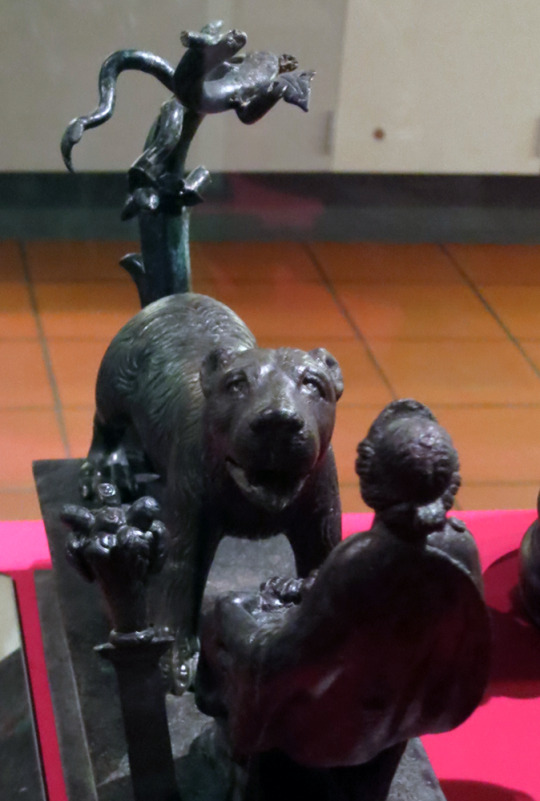
Goddess Artio - Bronze statuette - Muri - Bern
A magnificent bronze statuette was unearthed in Muri, in the Bern region. The base bears the words: Deae Artioni / Licinia Sabinilla (to the Goddess Artio, from Licinia Sabinilla). We see a small fruit tree quite bare. It bears only two branches, a leaf and two fruits. Its representation is reminiscent of the symbolism of the serpent, one of the main emblems of the Great Goddess. The serpent connects divinity to Knowledge and the Creation of the world. A bear on all fours, head raised and mouth ajar, stares at the goddess Artio. The attitude is not aggressive, but testifies to the power of the animal's presence. The representation of the goddess is apparently a later addition, corresponding to the Roman goddess Abundance. The Roman invader replaced as many Celtic deities as possible with his own. If an equivalent deity existed in the Roman pantheon, this took the place of the local deity. This explains why we find in France many temples dedicated to Mars, for example. Only the Celtic deities remained who could not be syncretized. But here, the dedication to Artio leaves no room for doubt. It is a tribute to the Bear Goddess. The statuette may have been restored following a partial destruction from a pre-existing work.
Artio is a Lady protector of Nature, she masters its wild forces. She is part of the large Potnia Theron family. This name historically corresponds to the Minoan Great Goddess, Mistress of wildlife. Today it is extended to numerous deities representing this same power. Protector, nurturer, guardian, her potentials are infinite. The symbolism of the bear connects the goddess to the laws and cycles of nature, to which the human submits if he wants to be able to survive.
The bear, a powerful yet tender and peaceful animal, is fertilized at the end of summer. In the fall she prepares for the big sleep. Indolence sets in, it feeds on anticipation. In winter, it hibernates, nestled in its cave. She explores the darkness of the soul, the world of dreams, of the impalpable. It is during this period that she gives birth to her baby, and breastfeeds him to strengthen him. In the spring, the bear and her cub finally come out to conquer the world. The sap circulates again in the plants, nature unfolds. In summer, generous nature offers its most precious fruits, and the bear is already stocking up for next winter. In many myths, the goddess gives birth to a young god at the same rate as the bear. This tribute to the intangible cycles of the Living is a constant in the devotion to the Ladies of ancient times.
Our Neanderthal cousin already seems to have revered the bear. An 80,000-year-old sanctuary that housed Neanderthal bones and those of bears under the same slab was discovered in the Régourdou cave in Périgord.
Homo sapiens has also integrated the bear into its places of worship. Thus, 30,000 years ago in the Chauvet cave, where bear skulls were intentionally placed. Likewise in the cave of Montespan where a clay statuette of the animal is associated with a real skull. Subsequently, many cultures integrate rituals and sometimes violent festivities around the bear throughout Europe, but also in Asia and America.
Christendom will vigorously fight against these practices deemed transgressive and diabolical. This will accelerate bear hunts and the virtual disappearance of the animal from our countries.

Day of the Bear - (Hartza eguna) - Pays Basque - France
However, the Nivkhes, an ethnic group from southern Russia, and the Ainu of Japan have long preserved a bear festival, linked to ancestral shamanic rituals. A bear cub captured in summer was fed and pampered by the women of the clan, before being put to death in winter in a sacred manner. This sacrifice is for these peoples a means of honoring the spirit of the bear, and of the divine. The bear is offered a fabulous banquet before being slaughtered. He then becomes the messenger of the tribe, and is supposed, once passed in the world of the invisible, to testify to the divinities and ancestors how much he has been honored, and to transmit messages and prayers to them. Thus, ensuring the protection of the whole clan for the coming year. Among the Basques, bears and humans have common ancestors. For them the bear symbolizes the return to life (spring), but also the resurrection. Many Basque festivals incorporate the "Day of the Bear" (Hartza eguna).
©Adelise Lapier
https://www.adelise-lapier.com/deesse-celte-artio-le-culte-de-l-ourse
#artio#celtic goddess#druidism#druidry#paganism#ursa#celtic mythology#bear#day of the bear#hartza eguna
40 notes
·
View notes
Photo

EPONA was a Celtic goddess. Her name contains an allusion to the horse: in Celtic, "epos" means “horse” and the suffix “-ona” affixed simply means “on”. Epona is the patron goddess of mares and foals. The oldest information about the Gallic goddess of horses is found in Juvenal (Satires, VIII, 155 ff). He writes: “... iurat / solam Eponam and facies olida ad praesepia pictas”. We can also find another text mentioning Epona in Minucius Felix (Octavianus, XXVII, 7): “Nisi quod vos et totos asinos in stabulis cum vestro vel [sua] Epona consecratis.”
The known inscriptions about Epona were excavated all around the territories corresponding to ancient Gaul and Germany, but also on the Danubian provinces, and even at Rome. The many inscriptions are often signed by soldiers, and found close to settlements, which seems to suggest that the inscriptions reveal, especially in the East, not an indigenous cult, but a military cult.
Epona occupied an important place in the Gallic religion, because the horse itself was important in the life of the Gauls.
Read More
151 notes
·
View notes
Text
an incomplete list of classics jokes that aren’t fucking funny:
haha the ancient greeks/romans were all gay!
roman imperialism. really.
the romans just stole their gods/myth/religion/culture from the greeks/anyone else they conquered
“historians”/classicists no-homo-ing achilles or alexander the great or sappho
the continuity of the roman empire into the modern era (holy roman empire, the catholic church, mussolini, fascism in general)
methods of torture/execution
pretty much anything caesar wrote about in the gallic wars
#there are SO many possible classics jokes that are really funny!!! you dont have to do this!!!#mine
620 notes
·
View notes